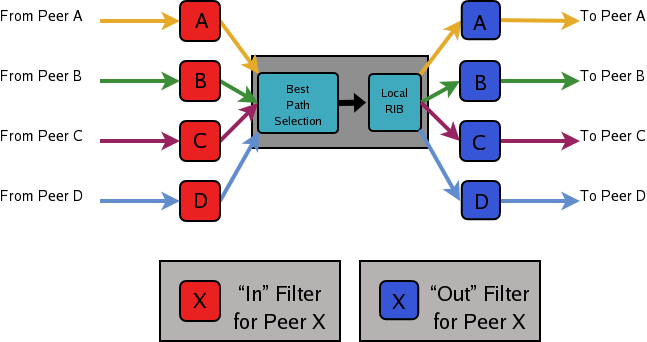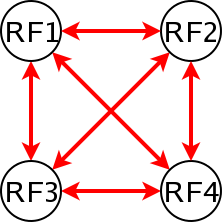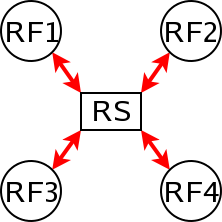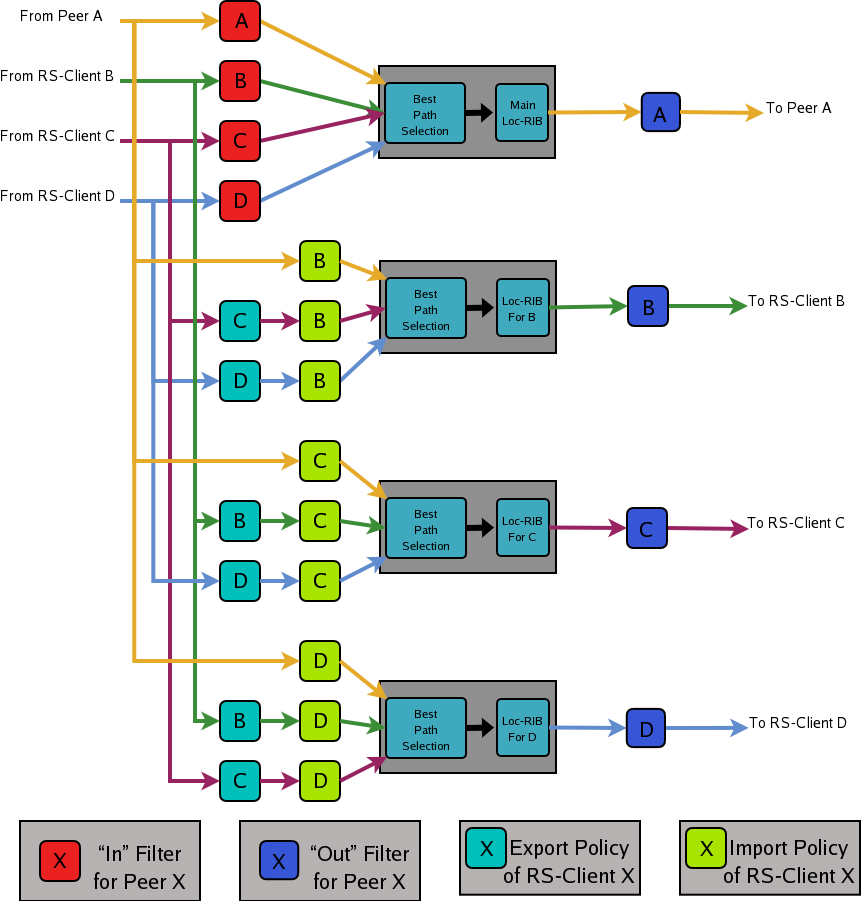Configuring FRR as a Route Server
The purpose of a Route Server is to centralize the peerings between BGP speakers. For example if we have an exchange point scenario with four BGP speakers, each of which maintaining a BGP peering with the other three (Full Mesh), we can convert it into a centralized scenario where each of the four establishes a single BGP peering against the Route Server (Route server and clients).
We will first describe briefly the Route Server model implemented by FRR. We will explain the commands that have been added for configuring that model. And finally we will show a full example of FRR configured as Route Server.
Description of the Route Server model
First we are going to describe the normal processing that BGP announcements suffer inside a standard BGP speaker, as shown in Announcement processing inside a ‘normal’ BGP speaker, it consists of three steps:
When an announcement is received from some peer, the In filters configured for that peer are applied to the announcement. These filters can reject the announcement, accept it unmodified, or accept it with some of its attributes modified.
The announcements that pass the In filters go into the Best Path Selection process, where they are compared to other announcements referred to the same destination that have been received from different peers (in case such other announcements exist). For each different destination, the announcement which is selected as the best is inserted into the BGP speaker’s Loc-RIB.
The routes which are inserted in the Loc-RIB are considered for announcement to all the peers (except the one from which the route came). This is done by passing the routes in the Loc-RIB through the Out filters corresponding to each peer. These filters can reject the route, accept it unmodified, or accept it with some of its attributes modified. Those routes which are accepted by the Out filters of a peer are announced to that peer.

Announcement processing inside a ‘normal’ BGP speaker

Full Mesh

Route server and clients
Of course we want that the routing tables obtained in each of the routers are the same when using the route server than when not. But as a consequence of having a single BGP peering (against the route server), the BGP speakers can no longer distinguish from/to which peer each announce comes/goes.
This means that the routers connected to the route server are not able to apply by themselves the same input/output filters as in the full mesh scenario, so they have to delegate those functions to the route server.
Even more, the ‘best path’ selection must be also performed inside the route server on behalf of its clients. The reason is that if, after applying the filters of the announcer and the (potential) receiver, the route server decides to send to some client two or more different announcements referred to the same destination, the client will only retain the last one, considering it as an implicit withdrawal of the previous announcements for the same destination. This is the expected behavior of a BGP speaker as defined in RFC 1771, and even though there are some proposals of mechanisms that permit multiple paths for the same destination to be sent through a single BGP peering, none are currently supported by most existing BGP implementations.
As a consequence a route server must maintain additional information and perform additional tasks for a RS-client that those necessary for common BGP peerings. Essentially a route server must:
Maintain a separated Routing Information Base (Loc-RIB) for each peer configured as RS-client, containing the routes selected as a result of the ‘Best Path Selection’ process that is performed on behalf of that RS-client.
Whenever it receives an announcement from a RS-client, it must consider it for the Loc-RIBs of the other RS-clients.
This means that for each of them the route server must pass the announcement through the appropriate Out filter of the announcer.
Then through the appropriate In filter of the potential receiver.
Only if the announcement is accepted by both filters it will be passed to the ‘Best Path Selection’ process.
Finally, it might go into the Loc-RIB of the receiver.
When we talk about the ‘appropriate’ filter, both the announcer and the receiver of the route must be taken into account. Suppose that the route server receives an announcement from client A, and the route server is considering it for the Loc-RIB of client B. The filters that should be applied are the same that would be used in the full mesh scenario, i.e., first the Out filter of router A for announcements going to router B, and then the In filter of router B for announcements coming from router A.
We call ‘Export Policy’ of a RS-client to the set of Out filters that the client would use if there was no route server. The same applies for the ‘Import Policy’ of a RS-client and the set of In filters of the client if there was no route server.
It is also common to demand from a route server that it does not modify some BGP attributes (next-hop, as-path and MED) that are usually modified by standard BGP speakers before announcing a route.
The announcement processing model implemented by FRR is shown in Announcement processing model implemented by the Route Server. The figure shows a mixture of RS-clients (B, C and D) with normal BGP peers (A). There are some details that worth additional comments:
Announcements coming from a normal BGP peer are also considered for the Loc-RIBs of all the RS-clients. But logically they do not pass through any export policy.
Those peers that are configured as RS-clients do not receive any announce from the Main Loc-RIB.
Apart from import and export policies, In and Out filters can also be set for RS-clients. In filters might be useful when the route server has also normal BGP peers. On the other hand, Out filters for RS-clients are probably unnecessary, but we decided not to remove them as they do not hurt anybody (they can always be left empty).

Announcement processing model implemented by the Route Server
Commands for configuring a Route Server
Now we will describe the commands that have been added to frr in order to support the route server features.
- neighbor PEER-GROUP route-server-client
- neighbor A.B.C.D route-server-client
- neighbor X:X::X:X route-server-client
This command configures the peer given by peer, A.B.C.D or X:X::X:X as an RS-client.
Actually this command is not new, it already existed in standard FRR. It enables the transparent mode for the specified peer. This means that some BGP attributes (as-path, next-hop and MED) of the routes announced to that peer are not modified.
With the route server patch, this command, apart from setting the transparent mode, creates a new Loc-RIB dedicated to the specified peer (those named Loc-RIB for X in Announcement processing model implemented by the Route Server.). Starting from that moment, every announcement received by the route server will be also considered for the new Loc-RIB.
- neigbor A.B.C.D|X.X::X.X|peer-group route-map WORD import|export
This set of commands can be used to specify the route-map that represents the Import or Export policy of a peer which is configured as a RS-client (with the previous command).
- match peer A.B.C.D|X:X::X:X
This is a new match statement for use in route-maps, enabling them to describe import/export policies. As we said before, an import/export policy represents a set of input/output filters of the RS-client. This statement makes possible that a single route-map represents the full set of filters that a BGP speaker would use for its different peers in a non-RS scenario.
The match peer statement has different semantics whether it is used inside an import or an export route-map. In the first case the statement matches if the address of the peer who sends the announce is the same that the address specified by {A.B.C.D|X:X::X:X}. For export route-maps it matches when {A.B.C.D|X:X::X:X} is the address of the RS-Client into whose Loc-RIB the announce is going to be inserted (how the same export policy is applied before different Loc-RIBs is shown in Announcement processing model implemented by the Route Server.).
- call WORD
This command (also used inside a route-map) jumps into a different route-map, whose name is specified by WORD. When the called route-map finishes, depending on its result the original route-map continues or not. Apart from being useful for making import/export route-maps easier to write, this command can also be used inside any normal (in or out) route-map.
Example of Route Server Configuration
Finally we are going to show how to configure a FRR daemon to act as a Route Server. For this purpose we are going to present a scenario without route server, and then we will show how to use the configurations of the BGP routers to generate the configuration of the route server.
All the configuration files shown in this section have been taken from scenarios which were tested using the VNUML tool http://www.dit.upm.es/vnuml,VNUML.
Configuration of the BGP routers without Route Server
We will suppose that our initial scenario is an exchange point with three BGP capable routers, named RA, RB and RC. Each of the BGP speakers generates some routes (with the network command), and establishes BGP peerings against the other two routers. These peerings have In and Out route-maps configured, named like ‘PEER-X-IN’ or ‘PEER-X-OUT’. For example the configuration file for router RA could be the following:
#Configuration for router 'RA'
!
hostname RA
password ****
!
router bgp 65001
no bgp default ipv4-unicast
neighbor 2001:0DB8::B remote-as 65002
neighbor 2001:0DB8::C remote-as 65003
!
address-family ipv6
network 2001:0DB8:AAAA:1::/64
network 2001:0DB8:AAAA:2::/64
network 2001:0DB8:0000:1::/64
network 2001:0DB8:0000:2::/64
neighbor 2001:0DB8::B activate
neighbor 2001:0DB8::B soft-reconfiguration inbound
neighbor 2001:0DB8::B route-map PEER-B-IN in
neighbor 2001:0DB8::B route-map PEER-B-OUT out
neighbor 2001:0DB8::C activate
neighbor 2001:0DB8::C soft-reconfiguration inbound
neighbor 2001:0DB8::C route-map PEER-C-IN in
neighbor 2001:0DB8::C route-map PEER-C-OUT out
exit-address-family
!
ipv6 prefix-list COMMON-PREFIXES seq 5 permit 2001:0DB8:0000::/48 ge 64 le 64
ipv6 prefix-list COMMON-PREFIXES seq 10 deny any
!
ipv6 prefix-list PEER-A-PREFIXES seq 5 permit 2001:0DB8:AAAA::/48 ge 64 le 64
ipv6 prefix-list PEER-A-PREFIXES seq 10 deny any
!
ipv6 prefix-list PEER-B-PREFIXES seq 5 permit 2001:0DB8:BBBB::/48 ge 64 le 64
ipv6 prefix-list PEER-B-PREFIXES seq 10 deny any
!
ipv6 prefix-list PEER-C-PREFIXES seq 5 permit 2001:0DB8:CCCC::/48 ge 64 le 64
ipv6 prefix-list PEER-C-PREFIXES seq 10 deny any
!
route-map PEER-B-IN permit 10
match ipv6 address prefix-list COMMON-PREFIXES
set metric 100
route-map PEER-B-IN permit 20
match ipv6 address prefix-list PEER-B-PREFIXES
set community 65001:11111
!
route-map PEER-C-IN permit 10
match ipv6 address prefix-list COMMON-PREFIXES
set metric 200
route-map PEER-C-IN permit 20
match ipv6 address prefix-list PEER-C-PREFIXES
set community 65001:22222
!
route-map PEER-B-OUT permit 10
match ipv6 address prefix-list PEER-A-PREFIXES
!
route-map PEER-C-OUT permit 10
match ipv6 address prefix-list PEER-A-PREFIXES
!
line vty
!
Configuration of the BGP routers with Route Server
To convert the initial scenario into one with route server, first we must modify the configuration of routers RA, RB and RC. Now they must not peer between them, but only with the route server. For example, RA’s configuration would turn into:
# Configuration for router 'RA'
!
hostname RA
password ****
!
router bgp 65001
no bgp default ipv4-unicast
neighbor 2001:0DB8::FFFF remote-as 65000
!
address-family ipv6
network 2001:0DB8:AAAA:1::/64
network 2001:0DB8:AAAA:2::/64
network 2001:0DB8:0000:1::/64
network 2001:0DB8:0000:2::/64
neighbor 2001:0DB8::FFFF activate
neighbor 2001:0DB8::FFFF soft-reconfiguration inbound
exit-address-family
!
line vty
!
Which is logically much simpler than its initial configuration, as it now maintains only one BGP peering and all the filters (route-maps) have disappeared.
Configuration of the Route Server itself
As we said when we described the functions of a route server (Description of the Route Server model), it is in charge of all the route filtering. To achieve that, the In and Out filters from the RA, RB and RC configurations must be converted into Import and Export policies in the route server.
This is a fragment of the route server configuration (we only show the policies for client RA):
# Configuration for Route Server ('RS')
!
hostname RS
password ix
!
router bgp 65000 view RS
no bgp default ipv4-unicast
neighbor 2001:0DB8::A remote-as 65001
neighbor 2001:0DB8::B remote-as 65002
neighbor 2001:0DB8::C remote-as 65003
!
address-family ipv6
neighbor 2001:0DB8::A activate
neighbor 2001:0DB8::A route-server-client
neighbor 2001:0DB8::A route-map RSCLIENT-A-IMPORT import
neighbor 2001:0DB8::A route-map RSCLIENT-A-EXPORT export
neighbor 2001:0DB8::A soft-reconfiguration inbound
neighbor 2001:0DB8::B activate
neighbor 2001:0DB8::B route-server-client
neighbor 2001:0DB8::B route-map RSCLIENT-B-IMPORT import
neighbor 2001:0DB8::B route-map RSCLIENT-B-EXPORT export
neighbor 2001:0DB8::B soft-reconfiguration inbound
neighbor 2001:0DB8::C activate
neighbor 2001:0DB8::C route-server-client
neighbor 2001:0DB8::C route-map RSCLIENT-C-IMPORT import
neighbor 2001:0DB8::C route-map RSCLIENT-C-EXPORT export
neighbor 2001:0DB8::C soft-reconfiguration inbound
exit-address-family
!
ipv6 prefix-list COMMON-PREFIXES seq 5 permit 2001:0DB8:0000::/48 ge 64 le 64
ipv6 prefix-list COMMON-PREFIXES seq 10 deny any
!
ipv6 prefix-list PEER-A-PREFIXES seq 5 permit 2001:0DB8:AAAA::/48 ge 64 le 64
ipv6 prefix-list PEER-A-PREFIXES seq 10 deny any
!
ipv6 prefix-list PEER-B-PREFIXES seq 5 permit 2001:0DB8:BBBB::/48 ge 64 le 64
ipv6 prefix-list PEER-B-PREFIXES seq 10 deny any
!
ipv6 prefix-list PEER-C-PREFIXES seq 5 permit 2001:0DB8:CCCC::/48 ge 64 le 64
ipv6 prefix-list PEER-C-PREFIXES seq 10 deny any
!
route-map RSCLIENT-A-IMPORT permit 10
match peer 2001:0DB8::B
call A-IMPORT-FROM-B
route-map RSCLIENT-A-IMPORT permit 20
match peer 2001:0DB8::C
call A-IMPORT-FROM-C
!
route-map A-IMPORT-FROM-B permit 10
match ipv6 address prefix-list COMMON-PREFIXES
set metric 100
route-map A-IMPORT-FROM-B permit 20
match ipv6 address prefix-list PEER-B-PREFIXES
set community 65001:11111
!
route-map A-IMPORT-FROM-C permit 10
match ipv6 address prefix-list COMMON-PREFIXES
set metric 200
route-map A-IMPORT-FROM-C permit 20
match ipv6 address prefix-list PEER-C-PREFIXES
set community 65001:22222
!
route-map RSCLIENT-A-EXPORT permit 10
match peer 2001:0DB8::B
match ipv6 address prefix-list PEER-A-PREFIXES
route-map RSCLIENT-A-EXPORT permit 20
match peer 2001:0DB8::C
match ipv6 address prefix-list PEER-A-PREFIXES
!
...
...
...
If you compare the initial configuration of RA with the route server configuration above, you can see how easy it is to generate the Import and Export policies for RA from the In and Out route-maps of RA’s original configuration.
When there was no route server, RA maintained two peerings, one with RB and another with RC. Each of this peerings had an In route-map configured. To build the Import route-map for client RA in the route server, simply add route-map entries following this scheme:
route-map <NAME> permit 10
match peer <Peer Address>
call <In Route-Map for this Peer>
route-map <NAME> permit 20
match peer <Another Peer Address>
call <In Route-Map for this Peer>
This is exactly the process that has been followed to generate the route-map RSCLIENT-A-IMPORT. The route-maps that are called inside it (A-IMPORT-FROM-B and A-IMPORT-FROM-C) are exactly the same than the In route-maps from the original configuration of RA (PEER-B-IN and PEER-C-IN), only the name is different.
The same could have been done to create the Export policy for RA (route-map RSCLIENT-A-EXPORT), but in this case the original Out route-maps where so simple that we decided not to use the call WORD commands, and we integrated all in a single route-map (RSCLIENT-A-EXPORT).
The Import and Export policies for RB and RC are not shown, but the process would be identical.
Further considerations about Import and Export route-maps
The current version of the route server patch only allows to specify a route-map for import and export policies, while in a standard BGP speaker apart from route-maps there are other tools for performing input and output filtering (access-lists, community-lists, …). But this does not represent any limitation, as all kinds of filters can be included in import/export route-maps. For example suppose that in the non-route-server scenario peer RA had the following filters configured for input from peer B:
neighbor 2001:0DB8::B prefix-list LIST-1 in
neighbor 2001:0DB8::B filter-list LIST-2 in
neighbor 2001:0DB8::B route-map PEER-B-IN in
...
...
route-map PEER-B-IN permit 10
match ipv6 address prefix-list COMMON-PREFIXES
set local-preference 100
route-map PEER-B-IN permit 20
match ipv6 address prefix-list PEER-B-PREFIXES
set community 65001:11111
It is possible to write a single route-map which is equivalent to the three filters (the community-list, the prefix-list and the route-map). That route-map can then be used inside the Import policy in the route server. Lets see how to do it:
neighbor 2001:0DB8::A route-map RSCLIENT-A-IMPORT import
...
!
...
route-map RSCLIENT-A-IMPORT permit 10
match peer 2001:0DB8::B
call A-IMPORT-FROM-B
...
...
!
route-map A-IMPORT-FROM-B permit 1
match ipv6 address prefix-list LIST-1
match as-path LIST-2
on-match goto 10
route-map A-IMPORT-FROM-B deny 2
route-map A-IMPORT-FROM-B permit 10
match ipv6 address prefix-list COMMON-PREFIXES
set local-preference 100
route-map A-IMPORT-FROM-B permit 20
match ipv6 address prefix-list PEER-B-PREFIXES
set community 65001:11111
!
...
...
The route-map A-IMPORT-FROM-B is equivalent to the three filters (LIST-1, LIST-2 and PEER-B-IN). The first entry of route-map A-IMPORT-FROM-B (sequence number 1) matches if and only if both the prefix-list LIST-1 and the filter-list LIST-2 match. If that happens, due to the ‘on-match goto 10’ statement the next route-map entry to be processed will be number 10, and as of that point route-map A-IMPORT-FROM-B is identical to PEER-B-IN. If the first entry does not match, on-match goto 10’ will be ignored and the next processed entry will be number 2, which will deny the route.
Thus, the result is the same that with the three original filters, i.e., if either LIST-1 or LIST-2 rejects the route, it does not reach the route-map PEER-B-IN. In case both LIST-1 and LIST-2 accept the route, it passes to PEER-B-IN, which can reject, accept or modify the route.